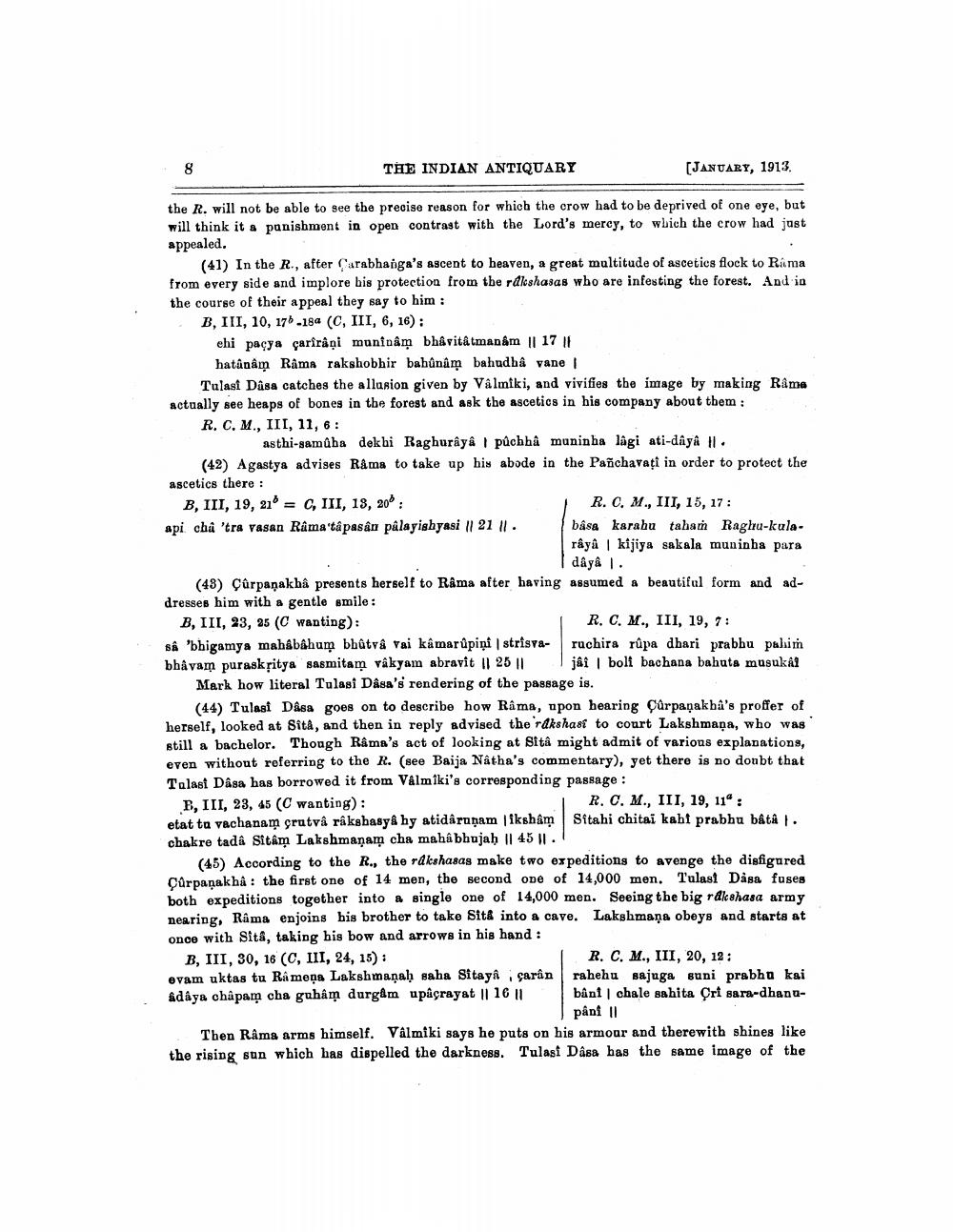________________
8
THE INDIAN ANTIQUARY
[JANUARY, 1913.
the R. will not be able to see the precise reason for which the crow had to be deprived of one eye, but will think it a punishment in open contrast with the Lord's mercy, to which the crow had just appealed.
(41) In the R., after Carabhanga's ascent to heaven, a great multitude of ascetics flock to Rama from every side and implore his protection from the rakshasas who are infesting the forest. And in the course of their appeal they say to him:
B, III, 10, 176-18a (C, III, 6, 16):
chi paçya çarîrâni muninâm bhâvitâtmanâm || 17 || hatânâm Rama rakshobhir bahûnâm bahudhâ vane |
Tulasi Dâsa catches the allusion given by Vâlmiki, and vivifies the image by making Râme actually see heaps of bones in the forest and ask the ascetics in his company about them:
R. C. M., III, 11, 6:
asthi-samûha dekhi Raghurâyâ
pûchhâ muninha lagi ati-dâyâ ||.
(42) Agastya advises Råma to take up his abode in the Pañchavati in order to protect the ascetics there:
B, III, 19, 21° C, III, 18, 20:
api cha 'tra vasan Râma tâpasan pâlayishyasi || 21 || .
R. C. M., III, 15, 17:
bâsa karahu taham Raghu-kularâyâ| kijiya sakala muninha para dâyên |.
(48) Çûrpanakha presents herself to Rama after having assumed a beautiful form and addresses him with a gentle smile :
B, III, 23, 25 (C wanting):
sâ 'bhigamya mahâbâhum bhûtvâ vai kâmarûpiņi | strîsvabhavam puraskritya sasmitam vâkyam abravit || 25 ||
Mark how literal Tulasi Dâsa's rendering of the passage is.
R. C. M., III, 19, 7:
ruchira rûpa dhari prabhu pahim jai boli bachana bahuta musuka?
(44) Tulasi Dasa goes on to describe how Râma, upon hearing Çûrpanakha's proffer of herself, looked at Sitâ, and then in reply advised the rakshast to court Lakshmana, who was still a bachelor. Though Rama's act of looking at Sitâ might admit of various explanations, even without referring to the R. (see Baija Nâtha's commentary), yet there is no doubt that Talasi Dâsa has borrowed it from Valmiki's corresponding passage:
B, III, 23, 45 (C wanting):
etat tu vachanam çrutvâ râkshasyâ hy atidâruņam |ikshâm chakre tada Sitâm Lakshmanam cha mahâbhujaḥ || 45 |
B, III, 30, 16 (C, III, 24, 15):
evam uktas tu Râmena Lakshmanah saha Sitaya çarân âdâya chapam cha guhâm durgâm upâçrayat || 16 ||
R. C. M., III, 19, 11":
Sitahi chitai kahi prabhu bâtâ.
(45) According to the R., the rakshasas make two expeditions to avenge the disfigured Çûrpanakha: the first one of 14 men, the second one of 14,000 men. Tulasi Dasa fuses both expeditions together into a single one of 14,000 men. Seeing the big rakshasa army nearing, Rama enjoins his brother to take Sit& into a cave. Lakshmana obeys and starts at once with Sitâ, taking his bow and arrows in his hand :
R. C. M., III, 20, 12:
rahehu sajuga suni prabhu kai bâni chale sahita Çri sara-dhanupâni ||
Then Râma arms himself. Valmiki says he puts on his armour and therewith shines like the rising sun which has dispelled the darkness. Tulasi Dâsa has the same image of the




